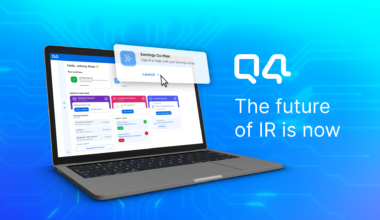While it’s been more than 6 months since COVID-19 entered our collective vernacular, the fallout from this pandemic continues to manifest and evolve. IRO’s across the globe are working hard to adapt to the impacts of this new world and the changes in investor expectations they drive.
Following the second earnings season in the COVID era, we continue to monitor investor expectations and how they are developing.
John Nunziati, investor relations partner at Q4, weighed in on what’s changed from last earning season. More importantly, John highlights the need for IROs to alter messaging accordingly in order to give the Street what it needs to evaluate their equity story.
Evolution Toward Longer-Term Positioning
During last quarter’s earnings season, investors wanted to hear from companies about the financial strength of the company and the steps being taken to preserve liquidity. Many companies needed to highlight metrics around cash position and burn rate as well as messaging that addressed steps being taken to ensure financial stability.
Investors wanted to understand the immediate response and impacts of the crisis, including how management was protecting employees and customers, operational changes, expected impact on revenue, and cost reduction efforts. Unfortunately, there was very little visibility available at that time and many companies responded by withdrawing annual guidance.
As we move through the current earnings season, with somewhat more stability evident, investor expectations continue to focus on the current environment’s impact on the business but are increasingly looking for clarity about the longer-term strategy and outlook going forward.
“IR teams have to ensure that messaging addresses both, but we’re seeing a significant shift toward an emphasis on the strategic efforts that will ensure longer term success,” says John. “Perhaps most importantly, they have to ensure that, in addition to the metrics that support these messages, management teams are starting to provide insight that is transparent and credible as investors continue to look for clarity.”
Lessons So Far in Investor Expectations
As we pass the height of this earning’s season, John and his team report that this transition from the immediate response toward longer term investor messaging is well underway. In fact, Q4 shares an earnings infographic every two weeks during the earnings cycle to help IRSP clients understand how their peers and the broader market are managing messaging and performing financially at this point in the recovery process.
These biweekly reports illustrate that results were actually fairly strong this earnings season, with more than 75% of the 447 S&P companies who had reported by August 14th beating analyst consensus. Of those companies, the average beat to EPS consensus is 22.5%. Over the past five years, the S&P 500 companies have averaged a quarterly beat to EPS consensus of about 7%.
While there are many valuable lessons in these updates, some companies working to focus investors on this longer term view are running into a real challenge – clarity may not yet be on the horizon. Whether they have the visibility they’d like or not, IROs are looking at the use of guidance and other metrics beyond financial to reframe their stories.
When COVID-19 hit, many companies were concerned enough about long-term visibility and unsure precisely how the pandemic would affect their business that they withdrew guidance. Now that visibility has improved, some are reinstating or updating. Of the 131 S&P companies who withdrew annual guidance last quarter and have already reported earnings, 22 have reinstated it. Of the 126 S&P companies that entered the quarter with annual guidance, approximately 55% have restated that guidance and 45% have reiterated.
Focus on ESG
Beyond guidance, many IROs are looking to ESG (Environmental, Social, and Governance) efforts to help guide investors toward a longer-term view. Beyond the pandemic, the second quarter of 2020 found the U.S. in the midst of a major social movement and companies responded by including messaging around social justice, diversity, and inclusion in earnings reports.
“As the pandemic unfolded, investor expectations focused on what companies were doing to protect employees, suppliers, and other stakeholders,” explained John. “The focus on ‘human capital’ became even more important following the death of George Floyd and resulting protests, serving as a driver for increased corporate efforts on improving equality, diversity, and inclusion.”
A number of companies have made commitments to changes in these areas. Investor relations teams will need to ensure their company maintains the transparency that management has committed to with ongoing reporting of progress. In addition, Blackrock, led by CEO Larry Fink, has continued to increase its push on corporations to address ESG issues. In mid-July, they identified 244 companies that they felt hadn’t yet made sufficient progress on integrating climate change risk into their models or disclosures. They also voted against management recommendations at 53 of those companies.
Job Well Done
This quarter, we’ve seen several companies successfully re-work their messaging to align with today’s current reality.
GoDaddy is an example of an increased focus on the longer-term. They are seeing a shift in the small business landscape with an increased emphasis on digital presence. They provided both quarterly and annual guidance, with management commentary pointing out share gains, actions they were taking to drive long-term growth and cash flow generation, and an acceleration driven by increased online commerce.
An example of a company facing challenges beyond the global pandemic for the past two earnings cycles, Jack in the Box took these battles head-on, focusing The Street on their execution both near and longer-term.
“The company’s CEO is new, and their July call was his first, as well as the first after the CFO announced that he would be leaving the company. As many others in their industry, they also experienced a revenue decline as a result of pandemic impacts,” explained John. “Despite these headwinds, they took on all three issues this quarter, detailing the CEO’s ramp-up, their pivot to address changing consumer behaviors, and their ‘cautiously optimistic’ outlook.”
Another example is Teledoc, who cited demand momentum and new opportunities during their earnings call. While many other companies choose not to provide any guidance, the indications they gathered gave them the confidence to provide a 2021 outlook for 30% to 40% revenue growth.
Final Thoughts on Investor Expectations
As IROs continue to evolve their messaging, having access to data and feedback will help companies prepare for the next earning season. Learn how by reading these three tips.


